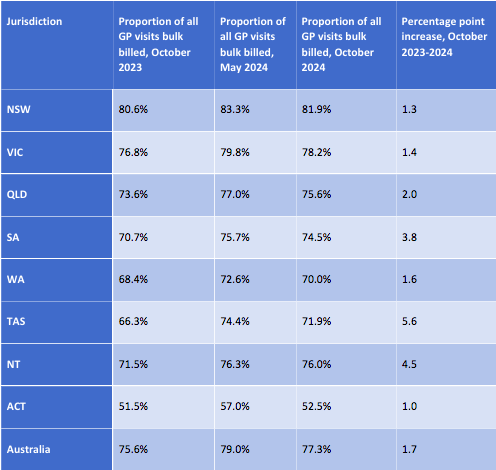The tripled BB incentive appears to have had the greatest impact in Tasmania and the Northern Territory, but the ACT still trails the pack.
There has been a modest rise in Australia’s GP bulk-billing rate compared to October 2023, despite falling levels compared to earlier this year.
Health Minister Mark Butler has released a new tranche of data to mark one year of the tripled bulk-billing incentive, revealing a 1.7 percentage point increase in proportion of GP visits that are bulk billed.
For the month of October 2023, the rate was 75.6%; for the month of October 2024, the rate was 77.3%.
It’s a slight dip from May 2024, when Mr Butler released data showing the bulk-billing rate was 79%.
The minister hailed the 1.7 percentage point increase as a win but noted that the country was “not out of the woods yet”.
“Bulk billing was in ‘free fall’, to use the words of the president of the College of General Practitioners at that time,” he said.
“It was in free fall and without that record investment the rate was going to continue to slide.
“The most important thing that we were able to do as a result of that investment was to stop the slide, and we have done that.”
The biggest shift was in Tasmania, which has historically seen low bulk-billing levels.
It went from the second-lowest bulk-billing rate in the country, at 66.3%, to the third lowest, at 71.9%; a rise of 5.6 percentage points over 12 months.
Again, this represents a long-term increase but a short-term decrease; according to the May data, Tasmania’s bulk-billing rate reached 74.4%, an increase of 8.1 points on October 2023.
The ACT, which continued to have the lowest bulk-billing rates in the country, also experienced the smallest rise in bulk billing over 12 months, going from 51.5% to 52.5%.

Source: Mark Butler release, November 2024, Mark Butler release, June 2024
In total, the 1.7 percentage point increase equates to an additional 5.4 million bulk-billed GP attendances over 12 months.
RACGP NSW and ACT chair Dr Rebekah Hoffman told The Medical Republic that the biggest shifts had been in non-metro areas, where the rebates were subject to loading based on rurality.
“Where the incentive actually did make a difference was in our really rural areas, those that are MM6 to MM7,” she said.
“There are a number of clinics that did change their billing practices and move from private-billing to mixed-billing in those areas.
“Some practices were considering moving to private billing, and this has enabled them to continue bulk billing for a little bit longer.
“Although there may not have been a dramatic increase, we did see that [the policy] stopped that shift towards private billing.”
The health minister did not rule out raising general practice rebates in the 2025 budget, but also pointed out that Labor’s two budgets have “delivered the two biggest increases across the board to the Medicare rebate in 30 years”.
“Now, we know it is still tough … to find a bulk-billing doctor in parts of the country, but we are starting to turn the corner,” Mr Butler said.
Related
“The changes and the investments we have made are starting to make a meaningful difference … at a time where we have started to turn the corner, that we’ve started to see more doctors, more bulk billing … the last thing Australia needs is for Medicare to be put back in the hands of Peter Dutton.”
In the lead-up to the election, Dr Hoffman said the college would be asking for an increase of at least 20% to the patient rebate for level C and D consults as well as mental health items.
It’s worth noting that Mr Butler releases bulk-billing rates that are averaged over a one-month timespan; when Medicare releases data, it tends to average the bulk-billing rate over three months or more.
Because of this, it is likely that the Medicare data for the July-to-September 2024 quarter will show a slightly different bulk-billing rate when it is released.





